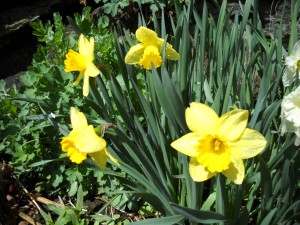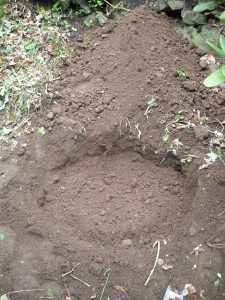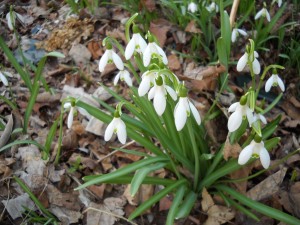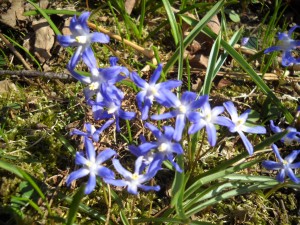Planting Bulbs
One of my very favorite gardening activities is planting bulbs on a sunny, crisp fall afternoon with Monarch butterflies flitting around and colorful leaves swirling in the air. Each year I plant anywhere between 50 and 300 bulbs and have done so for decades.
I accept that not every bulb I buy is going to last forever. I buy 50 to 100 tulips most years, and consider them annuals because they lose vigor each year, most disappearing after just a few years. I was at a garden center recently and bought 50 mixed tulips for $22. I planted them in one big clump, shoulder-to-shoulder, and will delight in them when they appear. I like tulips as cut flowers and give them away to friends who need a pick-me-up.
Yes, I know that rodents and deer like tulips. In my experience, squirrels dig up bulbs in the fall right after you plant them. They see the fresh, soft earth and say to themselves, Oh Boy! Treats! You can help to keep them from digging up the bulbs by laying chicken wire over the bed, and then covering with chipped branches or mulch of some sort. Not that a determined squirrel couldn’t get to them, it’s just my belief that squirrels are relatively lazy, and there’s plenty of other stuff to eat.
Back at the end of the Clinton era at the White House I got to interview the White House gardener. Gardeners there were busy planting hundreds – perhaps thousands – of a yellow tulip that someone thought Mr. Bush (elected, but not in office at the time) would enjoy. It was called the Hilary Rodham Clinton tulip, and I have never found it for sale, but I like the idea: gardening with giggles.
Anyhow, the Rose Garden is full of big fat gray squirrels. I asked Dale Haney, the gardener, how they dealt with the squirrels, and he told me about the chicken wire technique and one other. Your tax dollars are (or were then) at work buying 50 lb bags of corn. That’s right, they feed the squirrels, keeping them fat and happy, and the squirrels pretty much leave the gardens alone. If you try that approach, please don’t sue me if that only serves to invite all the neighbor squirrels to your yard. It just might.
Deer can be a problem when tulips are ready to bloom. You can repel them by using repellents made for the purpose, available at garden centers. Bobex is one particularly nasty smelling one that they hate. I have sprayed it on shrubs, but if you want to bring tulips into the house, I wouldn’t spray it on the flowers themselves, but around them. It loses its disgusting rotten egg-based smell after 2 to 3 days for us, but lasts much longer for deer.
Bulbs do best in rich, well drained soil. If you have heavy clay, it will stay wet and may rot some of your bulbs. If that is the case, dig a little deeper hole, and put a two-inch layer of compost in the bottom. I never plant bulbs one at a time. I always dig a hole big enough to hold at least a dozen bulbs, and plant them in a mass. It is much more dramatic, come spring.
According to the International Daffodil Register, there are 12 divisions (classifications) of daffodils based on physical looks and genetic background, and one last division based on botanical names only. All are mildly toxic if eaten, so rodents and deer leave them alone. The range of colors and flower type is truly mind-boggling. Go to your local feed-and-grain store or garden center to check out what is available. If you really want the unusual daffies, you may have to go on-line to a company like Brent and Becky’s or McClure and Zimmerman.
I like to plant early, mid-season and late-blooming daffodils, and read the labels carefully when buying to see their bloom season. One trick to keep in mind next spring is this: cut the spent flowers off after blooming, so the plants do not waste energy making seeds. But don’t cut back the foliage until it turns brown. The leaves are “re-charging” the bulbs. I like to plant clumps of daffies between clumps of hostas – the hosta leaves hide the daffodil foliage after blooming.
Get adventurous when you plant this year. A great early summer bloomer is giant snowflake (Leucojum aestivum) which looks like a snowdrop on steroids. These lovelies are 12 or more inches tall and are nice cut flowers. Snowdrops, of course, are essential to any garden. If you plant them on a south-facing hillside, you should get blossoms in early March unless they are planted where snow slides off the roof.
So get outdoors and plant bulbs. You’ll be rewarded with blossoms just when you need them most – after the dreariness of winter.
Web Extra: Other great bulb plants include Scilla and glory of the snow, both very early blooming. Both are blue to purple, and quite short – 4 inches tall or so. Scilla blossoms look down, while glory of the snow looks up and shows it white and yellow throat. Don’t dismiss them as cut flowers just because they are short – they are available when other things are not.
Winter aconite is lovely, too. This is an early yellow flower that is low to the ground. It has 5 or 6 petals that look up, as bright as any daffodil. It is marginally hardy in my Zone 4 garden, and I seem to lose them some times, but I consider them worth re-planting to keep a small supply going.
Henry’s new book, Wobar and the Quest for the Magic Calumet will be in bookstores October 15. For information about it go to Henry’s Web site, www.Gardening-Guy.com.







